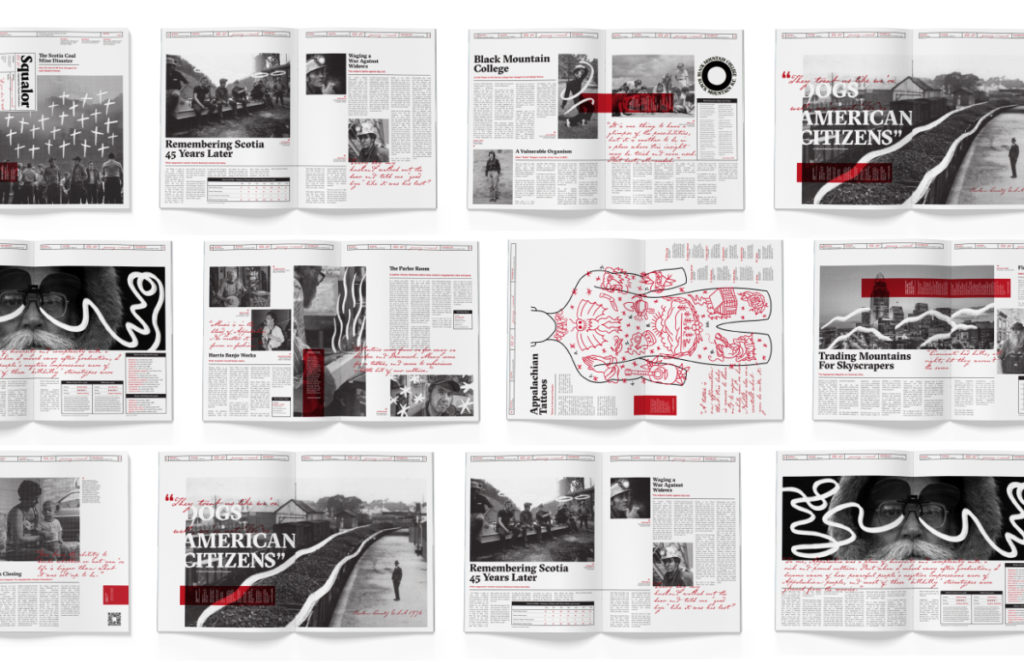Our urban Appalachian community is alive with people who are hard at work carving out new avenues for Appalachian voices. The Urban Appalachian Community Coalition has highlighted some of these voices recently in the online reading by Ohio Appalachian authors, “Don’t Cry for Us, J.D. Vance.” Jordan Hackworth has been creating a space for himself as an urban Appalachian and for Appalachians in general with his graphic design work and his online magazine. I was fortunate enough to talk to Jordan Hackworth about his work.
Jordan Hackworth grew up in Harlan County, Kentucky. He spent his first 18 years living in his grandmother’s house. He describes himself as “the last son of a coal miner. There will not be any more coal miners in my family.” His grandfather died in the Scotia Mining disaster when his father was just three years old. These features of his life and background weigh heavy on Jordan and set the ground for what he is doing now.
Like so many young Appalachians, Jordan didn’t think much about Appalachian identity growing up. “We were just normal kids, skateboarding and living like young punk rockers like everyone else,” he told me. It was after moving away that his Appalachian culture and identity began to take precedence. Jordan Hackworth relocated to greater Cincinnati to attend Northern Kentucky University and study graphic design. But he brought the momentum of his Appalachian upbringing with him. Like so many people who grow up in the Appalachian regions, it was not until leaving that he became acutely aware of his own culture.
Jordan Hackworth edits an online magazine called Squalor. Jordan explained that the magazine was a logical extension of his commitment to Appalachia and Appalachian people: “Squalor was a way to highlight Appalachia in ways that were not caught up in negative assumptions about Appalachian people.” His motivation for this project is deeply personal. “Every article ties back to my own journey as an Appalachian.” This personal and political commitment is clear in the article that covers the Scotia Mine disaster. For readers who may not know, the Scotia Mine explosions occurred in 1976 and resulted in the deaths of 26 miners, 11 of which had been entombed in the mine for 253 days. This is the same mining disaster that claimed the life of Jordan Hackworth’s grandfather. With photographs that accompany the text and handwritten notes layered over the images, Squalor provides history as it layers personal attachments that foreground the very personal ways this event impacted people’s lives, including Jordan Hackworth’s own family.

Squalor covers a range of topics. It includes articles on Black Mountain College, the experimental college in North Carolina that gave us a long list of influential artists. The magazine highlights a banjo maker from Harlan County, Kentucky. Handmade banjos in the mountain tradition from a man who makes them one at a time. As if to remind us that Appalachia keeps on changing with the rest of the country, there is an article on a local tattoo artist. Squalor features articles that describe the contemporary experience of urban Appalachians. Jordan Hackworth covers the history, culture, politics, and art of Appalachia, both urban and rural, through the lens of his online magazine. As for the name, he explains that he deliberately used a term that has been historically used to disparage Appalachian people in order to re-direct the meaning of the word: “This is an act of semantic shift, or amelioration. Taking a word used to degrade and belittle Appalachian’s, now to uplift and evoke new and creative thinking.” The rhetorical act of semantic shift is a political maneuver that demonstrates the way a people, in this case Appalachian, can take control of the narrative and re-make that narrative in their own terms.
Jordan Hackworth, whose profile is up on the UACC Cultural Resource Directory, stays busy with his work as a freelance graphic designer. He is focusing on brand design primarily for small businesses. He said his plans “are to focus on graphic design and branding design for small Appalachian-owned businesses.” This work includes that banjo maker, Harris Banjo Works in Harlan. He is involved in other work that may prove to be far-reaching. Jordan is working with the Appalachian Citizens Law Center providing work that assists their mission in representing individuals and their fight for justice in the coalfields. Jordan Hackworth’s interests and commitments run far and wide, and he doesn’t show any signs that he is getting tired. In fact, with plans for graduate school in graphic design, he is just getting started.

We can see in Jordan Hackworth two aspects of the urban Appalachian experience. On the one hand, he is part of the younger generation of urban Appalachians who are tapped into features of Appalachia that are entirely new. The contemporary business of branding stands out, and his attention to new artists is another. At the same, time, Jordan Hackworth is part of that long stream of people who make their way from Appalachia to places like greater Cincinnati and bring with them the culture and spirit of their home. The continuity of the Appalachian region and people is what remains constant. As the Urban Appalachian Community Coalition looks to the next generation of urban Appalachians, Jordan Hackworth stands out as exemplary of the folks we want to pay attention to as they redefine the modern world while keeping alive the spirit and culture of Appalachia.
Mike Templeton is a writer, independent scholar, barista, cook, guitar player, and accidental jack-of-all-trades. Check out his profile in UACC’s new Cultural Directory. He lives in downtown Cincinnati with his wife who is a talented photographer. They spend their free time walking around the city snapping photos. She looks up at that the grandeur of the city, while Mike always seems to be staring at the ground.

